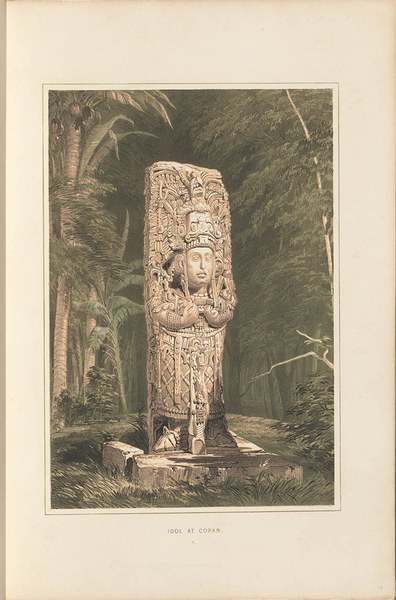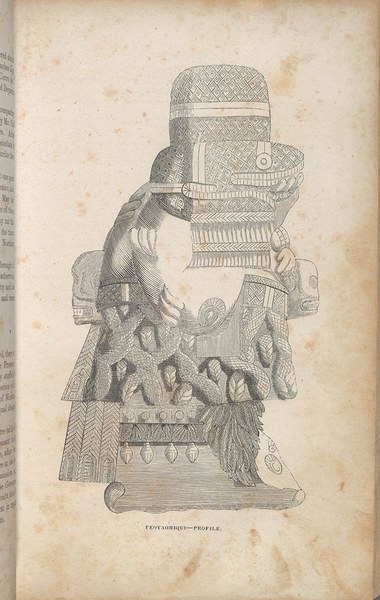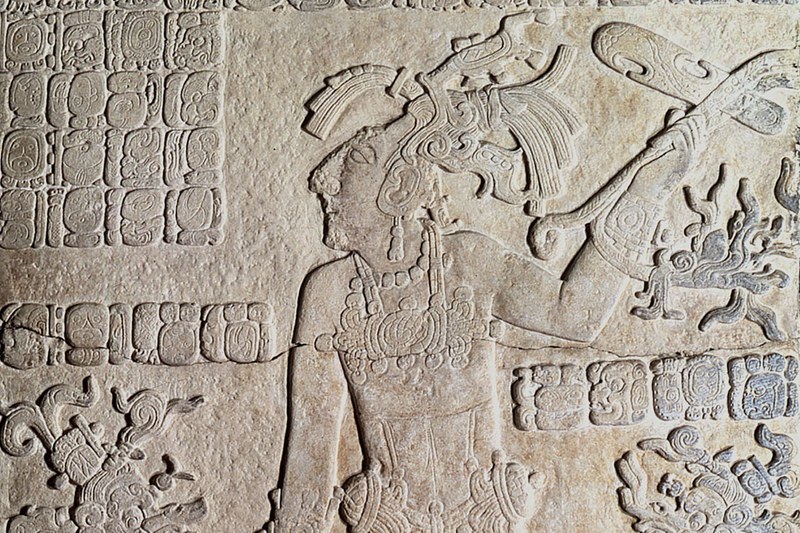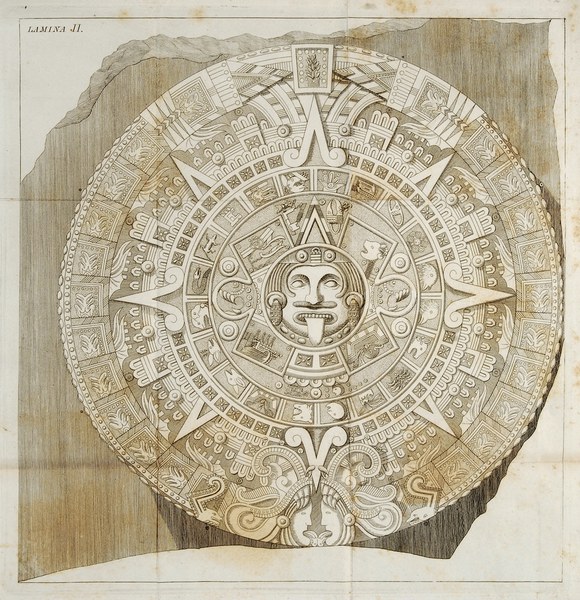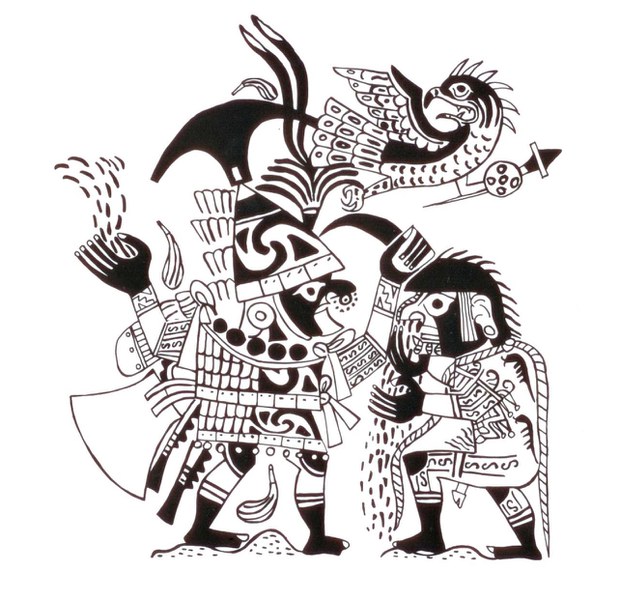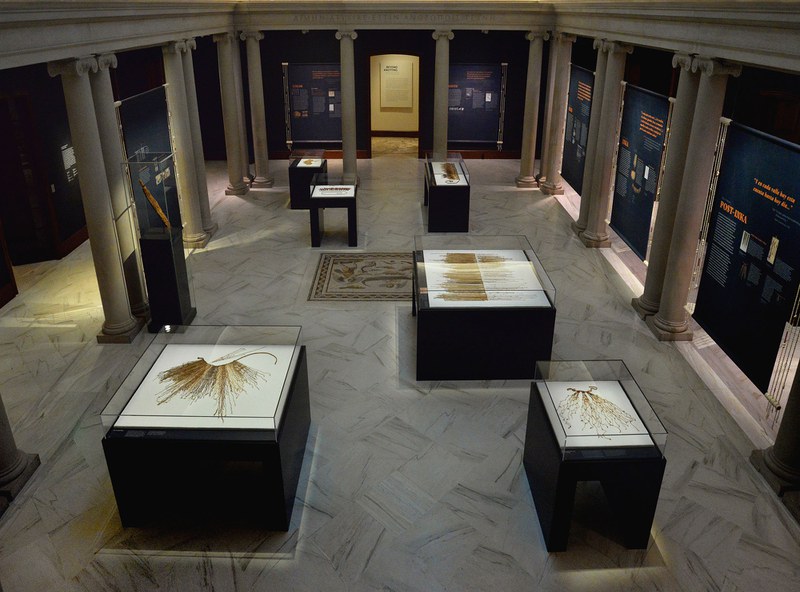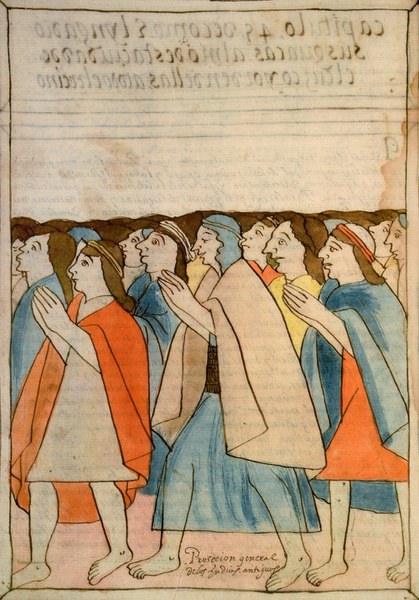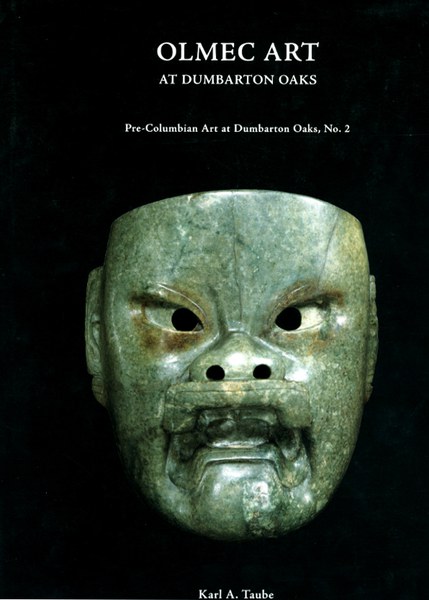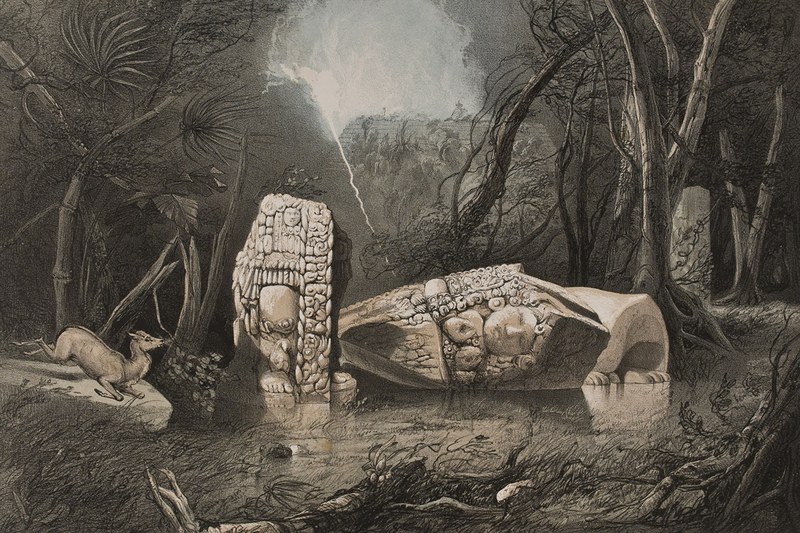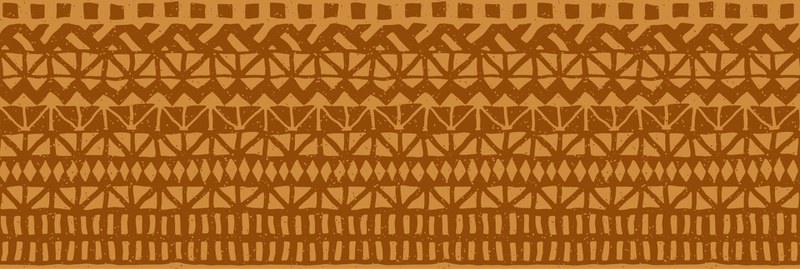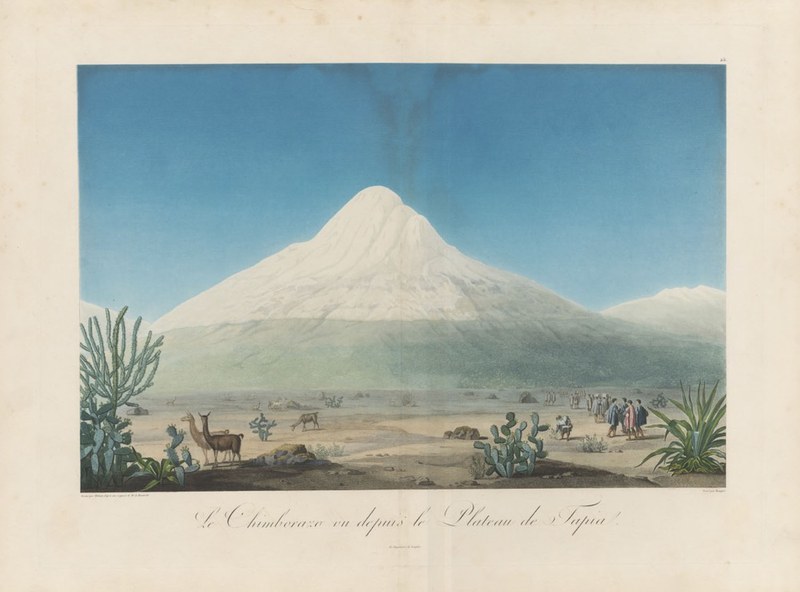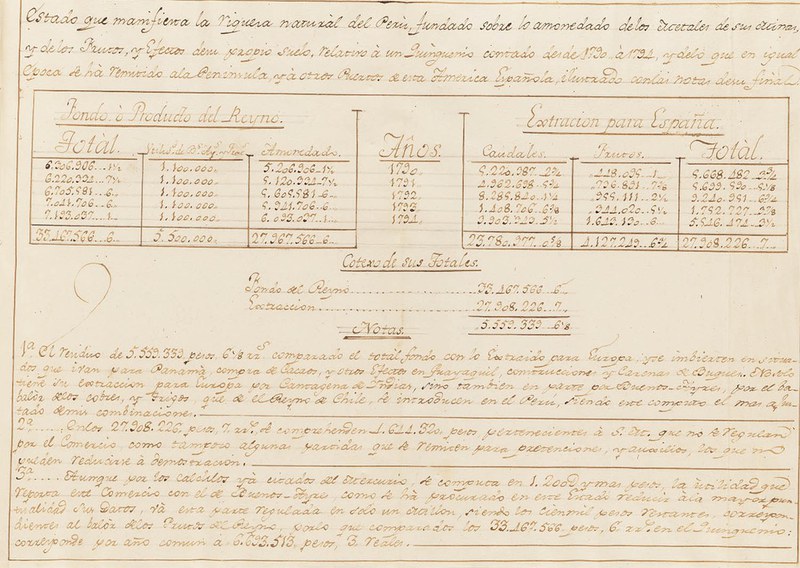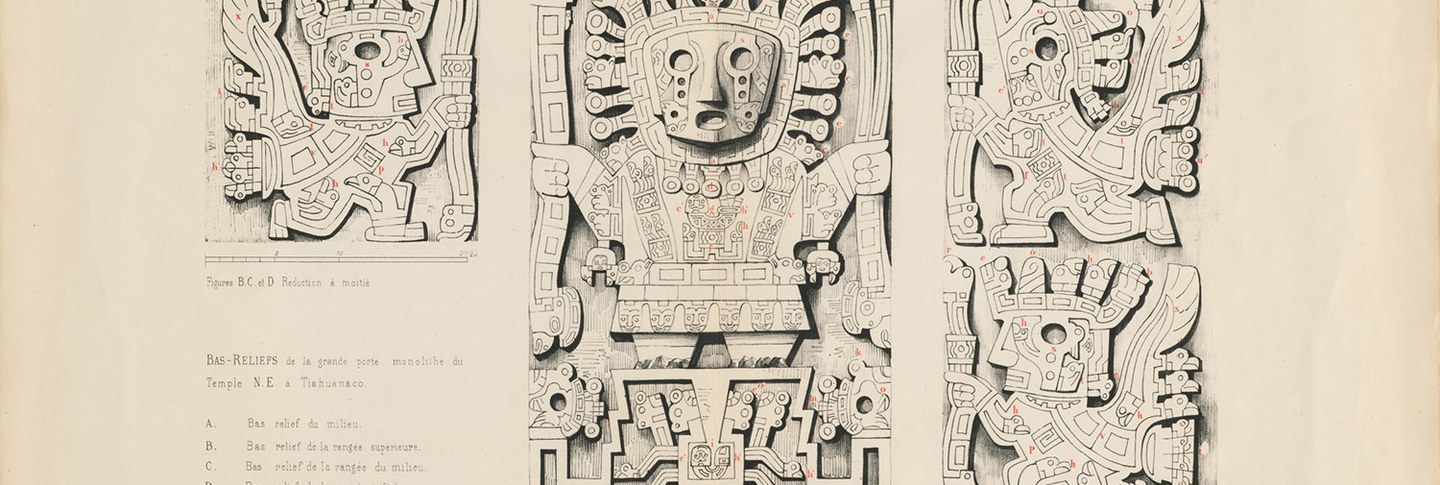
Pre-Columbian Art and Archaeology
Rare Books Museum Collections Library and Archival Collections Online Exhibits Publications External Resources Related Content
Remnants of pre-contact civilizations of Mesoamerica and greater Central America—cities and ritual sites lost in the tropical jungle—lured eighteenth- and nineteenth-century travelers and archeologists. Their descriptions of places that they had explored often included drawings, prints, and photographs, revealing how these Pre-Columbian monuments were perceived and recorded by their first visitors and scholars. Although one of the earliest of these accounts, Antonio del Río’s discovery of Palenque in 1787, was published only in 1822 in an English translation (with important additions by Paul-Félix Cabrera), its influence was comparable to that of Alexander von Humboldt’s Vues des cordillères, et monumens des peuples indigènes de l’Amérique (1810), which combined the author’s interests in art, natural history, and material culture of the indigenous peoples of the Americas.
Pedro Márquez’s Due antichi monumenti di architettura messicana (1804) was one of the first works devoted to Mexican archaeology to be published in Europe. It was followed by such richly illustrated volumes as Antiquités mexicaines (1834)—a report on Guillaume Dupaix’s three expeditions in 1805–07 to Palenque and Mitla, the last of the Spanish crown’s surveys of Mesoamerica—and Frederick Catherwood’s Views of Ancient Monuments in Central America, Chiapas and Yucatan (1844), based on John Lloyd Stephens’s journeys through Honduras, Guatemala, and Mexico in 1839–41. Consonant with the rise of Mexican nationalism was a scholarly treatise by the astronomer Antonio de León y Gama (1832) that showcased Piedra del Sol—the sacrificial calendar stone discovered in Mexico City in 1790—praising the Aztec society for its scientific and artistic achievements.
The album of fifty photographs of Mitla previously owned by a prominent German anthropologist Eduard Georg Seler is a unique testimony to the appearance of the important Zapotec site at the turn of the twentieth century. The Histoire des pyramides de Quito by Charles-Marie La Condamine, included in his account of the 1735–43 scientific expedition to South America, is a rare eighteenth-century description of the Andean monuments.
Searching for Materials in HOLLIS
In addition to select digitized titles, the Dumbarton Oaks Rare Book Collection holds numerous materials related to Pre-Columbian art and archaeology. To quickly locate items in HOLLIS, use the “Advanced Search” feature to specify material subject, language, date range, or other criteria. Relevant subjects include the following:
Indians of Mexico -- Antiquities
South America -- Description and travel
Digitized Rare Books
Museum Collections
Library and Archival Collections
The Bliss Travel Archive, Guatemala, 1935, features 132 unpublished photos documenting Robert Woods Bliss’s journey to Guatemala after he retired from the diplomatic service. The photographs are accompanied by information derived from Bliss's travel journal and letters to his wife, Mildred Barnes Bliss.
The Christopher B. Donnan and Donna McClelland Moche Archive, 1963–2011, documents the art and iconography of the Moche, and comprises photographic materials and fineline drawings. A selection of the fineline drawings is made available through the Moche Iconography research portal (also available in Spanish).
The Donald Proulx Nasca Archive provides visual support for the iconographic categories established in Proulx’s 2006 A Sourcebook of Nasca Ceramic Iconography. It includes photographs of Nasca vessels as well as cards with photocopied iconographic elements, arranged according to Proulx’s categories.
The Roosevelt and Cross Archive, Peru, 1934, documents the expedition of Cornelius van S. Roosevelt and Richard J. Cross, accompanied by noted Peruvian archaeologist Dr. Julio C. Tello, to explore important pre-Hispanic sites of the Ancash region, Peru. The online feature makes 355 selected photos, including several pictures showing the historical figure of Julio C. Tello in the field, early photographs of important sites like Chavîn de Huántar and Chanquillo, as well an extensive documentation of Chavín tenon heads, striking views of El Lanzón, and diverse Recuay stone sculpture.
The Yuri Valentinovich Knorozov Papers, 1945–1998, contain correspondence, manuscripts, notes, journal offprints, and photographs from the personal papers of Knorozov, the Russian anthropologist and linguist famous for his breakthrough in the decipherment of Maya writing.
In addition to the above, the Dumbarton Oaks Museum’s Pre-Columbian Photographs and Fieldwork Archives contains the following collections: Anne Paul, Paracas Textile Archive; Dallenback Archive of Stone Sculpture from Colombia; Nicholas Hellmuth: Maya Ceramic Archive; Robert Woods Bliss Personal Archive of 1958 Catalogue of Pre-Columbian Art; Thelma Sullivan Archive; Thomson Expedition Archive, Yucatan, Mexico, 1888; and Vergara Archive of Pyroengraved Gourds from Peru.
Online Exhibits
Explore highlights from the collection related to botanical illustration below, or view all online exhibits.
Publications
See featured titles and series below, and search all titles from Dumbarton Oaks Publications.
External Resources
The John Carter Brown Library is an independently funded research library located on the campus of Brown University. The library’s collection has increasingly emphasized indigenous language materials and other sources related to America’s earliest indigenous inhabitants. High resolution images of the library’s archive of early American images, map collection, and political cartoon collection are available through LUNA, and scans of over 10,000 full books are available through Internet Archive.
European Views of the Americas: 1493 to 1750 is a searchable database of publications about the Americas written in Europe before 1750. It includes thousands of valuable primary source records covering the history of European exploration, as well as portrayals of Native American peoples.
The Met’s Heilbrunn Timeline of Art History pairs essays and works of art with chronologies, telling the story of art and global culture through the Museum’s collection. Users can explore works of art by time period, geographical region, or thematic categories, such as Art in the Americas, and consult contextualizing essays using the same filters.
The National Museum of Anthropology's (MNA) extensive collections of archaeological and ethnographic objects preserve Mexico’s cultural heritage and offer insight into the worldview and daily life of the country’s indigenous peoples. Through a robust digitization project, the museum has been making their collection more widely accessible. Curated collections in the archaeological and ethnographic departments, for example the Mayas, can be filtered by object type and material, although these facets are only offered in Spanish.
The UCLA Library has produced a thorough subject guide for Mesoamerican and Pre-Columbian Art. The guide includes links to relevant electronic journals and subject-focused databases, as well as to digitized materials from major Pre-Columbian collections and images of archaeological sites.
The Precolumbian Sites Album, part of the University of New Mexico’s digital collections, contains prints depicting various Pre-Columbian archeological sites of Meso-America. Several significant architectural structures are shown prior to excavation and their current reconstruction. Sites included are Acambalam, Chiapas, Chichén-Itzá, Chunkanab, Hochab, Isla de Mujeres, Mitla, Nancuchich, Oaxaca, Palenque, Tantah, Tchpich, Uxmal, Xcakochna, Xkichmol, Xlottsal and Yucata.
The Museo Larco was established in 1926 by Rafael Larco Hoyle, a pioneer of Peruvian archaeology, and it houses around 45,000 pieces of Pre-Columbian art and other archaeological objects. The Museo Larco was the first museum in Latin America to electronically catalogue its entire collection, and since 2007, the entire collection has been accessible to the general public online.
ARCHI: Archivo Digital de Arte Peruano is a platform dedicated to documenting and disseminating the cultural heritage of Peru. An initiative of the Lima Art Museum - MALI and the Daniel Giannoni Photographic Archive, in agreement with the Ministry of Culture of Peru, this database provides free access to images of the art, material culture and architecture of Peru from the pre-Hispanic times to the present.
Related Collection Strengths
Learn more about other collection strengths that may contain materials of interest to this research topic, or view all collection strengths.
Related Content
Discover related news, resources, and opportunities at Dumbarton Oaks.
